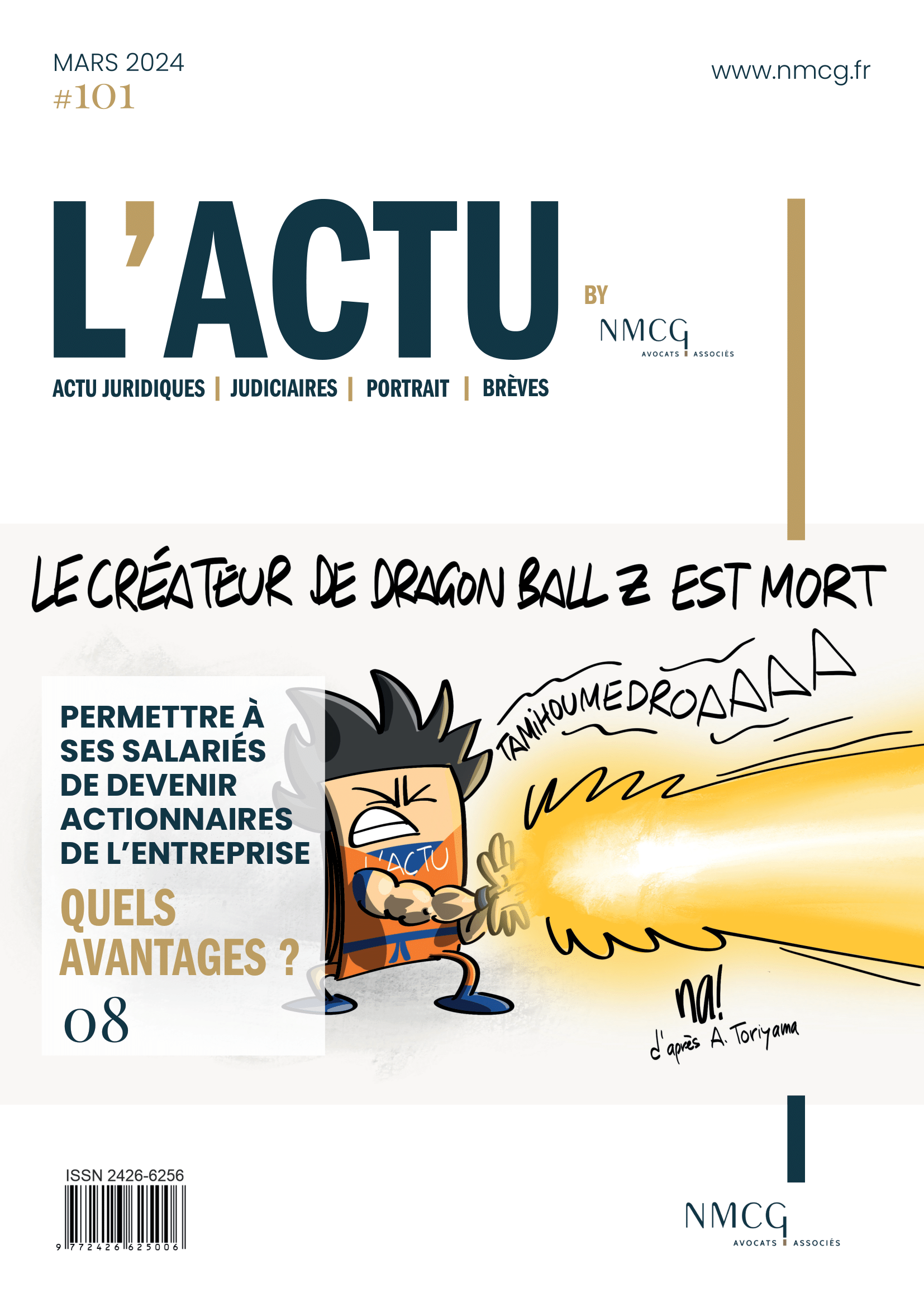Compensation for personal injury resulting from a work-related accident
31 March 2023
In France, when an employee is the victim of a work-related accident, he or she may be entitled to compensation for the physical injuries suffered.
This compensation can be granted by the Health Insurance or by the employer, depending on the origin of the accident and the seriousness of the injuries.
The workers’ compensation system is governed by the Social Security Code.
According to this code, compensation is granted to employees who are victims of a work-related accident that occurs during or in connection with their work. The work-related injury must have resulted in a personal injury or an occupational disease.
Article L411-1 of the Social Security Code states:
“An accident at work, regardless of its cause, is an accident that occurs as a result of or in the course of work to any person employed or working, in any capacity or in any place whatsoever, for one or more employers or company managers.
It is therefore interesting to consider the conditions and scope of compensation for the resulting physical damage, given the diversity of possible situations.
Thus, an employee’s personal injury can occur in multiple situations.
- Accident following a task carried out within the framework of its mission, whether it takes place in the company, or outside.
- Accident on the way to work: journey between home and work, journey between work and the place where the employee usually takes his meals, without detour during the journey (L 411-2 of CSS)
It is important to note that by default, THE WORK ACCIDENT IS COMPENSATED BY THE SOCIAL SECURITY
Article L 431-1 of the CSS specifies that the benefits granted to beneficiaries, which are the responsibility of the health insurance funds, include
1°) the coverage of medical expenses in a broad way, medical transport expenses, rehabilitation and re-education expenses, the expenses of reclassification and professional retraining
2°) the daily allowances paid to the victim during the period of temporary incapacity which obliges him to interrupt his work;
3°) benefits other than annuities, due in case of accident followed by death;
4°) for victims with a permanent work disability, a lump-sum payment when the degree of disability is below a certain level, an annuity above that level and, in the event of death, the annuities due to the victim’s beneficiaries.
This lump-sum compensation prevents the victim from taking legal action under the conditions of ordinary law to obtain full compensation for his or her loss.
There are exceptions to this rule, some of which are described below: traffic accidents, the fault of a third party, intentional fault on the part of the employer, or conditions not covered by the employer.
The question then arises as to the compensation of the employee when he or she retains after-effects, i.e. when he or she is permanently disabled after consolidation.
The first step is the evaluation of the permanent disability rate:
The rate of permanent disability is determined according to the nature of the disability, the general state of health, the age, the physical and mental faculties of the victim, as well as his or her aptitudes and professional qualifications, taking into account an indicative scale of disability.
This rate is set by the social security doctor after a medical assessment.
If the degree of disability (IPP) is less than 10%, the victim receives a lump-sum compensation paid in one go: in Capital
If the degree of disability is equal to or greater than 10%, the victim receives a life annuity until death.
However, certain hypotheses entitle the salaried victim to obtain additional compensation.
In addition to the additional compensation that may be requested, the option for victims to have recourse to common law also entitles them to an evaluation of their after-effects independently of the rate used by the social security.
This is now also the case in the hypothesis of the employer’s inexcusable fault, by virtue of a particularly recent reversal of case law, detailed below.
The fault of a third party
When the accident is caused by a third party outside the company, the victim or his or her beneficiaries have the right to take action under common law to obtain compensation for losses not covered by social security benefits.
Provided that, except in the case of a traffic accident, third parties are defined as persons other than the employer and his employees.
This is also possible in the case of shared liability between the third party and the employer or his agent (Cass. ass. plén. 22-12-1988 n° 85-17.473: RJS 2/89 n° 193 ).
The Fund will then be able to claim its debts from the third party responsible, and obtain reimbursement of the benefits paid.
The employer will also be able to seek compensation from the third party for the damage that he himself has suffered, such as the reimbursement of salaries, including charges, paid during the work stoppage (Cass. ass. plen. 30-4-1964 n° 62- 11.135 and 61-13.793).
On the other hand, and except for the employer’s intentional fault (Cass. 2e civ. 29-11-2018 n° 17-17.747 F-PB: RJS 2/19 n° 127), the third party condemned to compensate the victim’s prejudice will not be able to exercise a recourse against this employer (or his employee) nor against his insurer, even if they share the responsibility of the accident (Cass. ass. plen. 31-10-1991 n° 88-17.449; n° 88-19.689; n° 89-11.514: RJS 1/92 n° 78)
The victim’s recourse against the liable third party is not subordinated to the prior exercise of a recourse against the employer (Cass. 2e civ. 4-4-2013 n° 12- 13.921 F-PB : RJS 6/13 n° 487).
The traffic accident
When the accident qualified as an accident at work occurred on a on a road open to public traffic and involving a motorized land vehicle driven by the employer, an employee or another person belonging to the same company as the victimor his or her assigns and the fund may bring an action against the liability action against the perpetrator of the accident in the same conditions than those provided for in case of fault of a third party.
The victim or his or her heirs may then claim, in addition to the lump-sum compensation from the social security, the indemnity provided for by the law of 5-7-1985 fixing the rules for compensation for traffic accidents.
This implies that the victim has the right to act on the basis of the Badinter law, and thus obtain full compensation for his damages.
Excluded in principle from the scope of application of the supplementary compensation are accidents occurring on the premises of the company or inside a construction site, or while the vehicle is stationary (Cass. 2e civ. 5-2- 2015 n° 13-26.358: R)S 4/15 n° 288).
Finally, it will be specified that compensation for traffic accidents and inexcusable fault of the employer are cumulative (Cass. 2nd civ. 12-7-2012 n° 11-20.123 : RJS 11/12 n° 900 rectified by Cass. 2nd civ.10-2-2005 n° 03-11.316 FS-D ).
The inexcusable fault of the employer
The inexcusable fault of the employer implies that the latter fails in his obligation of safety of result for which he is responsible.
This inexcusable fault is retained when the employee demonstrates that his employer should have been aware of the danger of the situation and did not take the necessary measures to prevent it.
Inexcusable fault can be invoked when an employee of the employer does not fulfill the safety obligation.
It should be noted that there has been a jurisprudential evolution in the definition of the employer’s inexcusable fault, the scope of which has been considerably broadened.
The inexcusable fault was originally defined as a fault ” of exceptional gravity, deriving from a voluntary act or omission, from the awareness of the danger that its author must have had, from the absence of any justifying cause and being distinguished by the lack of an intentional element of the intentional fault“.
From now on, the judges state: ” by virtue of the employment contract binding him to his employee, the employer is bound to the latter by an obligation of safety of result, in particular with regard to occupational diseases (and accidents at work) contracted by this employee as a result of the products manufactured or used in the company; the breach of this obligation has the character of an inexcusable fault (…) when the employer was or should have been aware of the danger to which the employee was exposed and did not take the necessary measures to protect him“.
With this principled solution, inexcusable fault is now based on three elements:
- it is first of all indissolubly linked to the contractual obligation of safety incumbent on the employer. Because it constitutes an obligation of result, the employer fails in this safety obligation and commits “a fault“
On this point, it will be noted that this is an inconsistency in the legal sense of the term, insofar as an obligation of result is in principle based on liability without fault.
However, this reasoning aims to allow the victim to obtain the best possible compensation, by abandoning the exceptional gravity of the fault.
- It is therefore necessary that the employer was or should have been aware of the danger, and that he did not take measures to preserve the employee from this danger, in order to qualify the inexcusable fault.
To evaluate the awareness of the danger that the employer had or should have had, a key element, the judges make an assessment in abstracto, by reference to a normally diligent behavior of an employer in such circumstances, taking into account the scientific knowledge current at the time of the accident, and the texts in force.
The absence of measures necessary to preserve the health of the employee will be induced by the absence of precautions taken by the employer or their insufficiency.
- It will also be necessary to prove the causal link between the fault and the damage.
On this point, the jurisprudential position has also become more flexible, insofar as it is now irrelevant whether the employer’s inexcusable fault was the determining cause of the employee’s accident.
It is sufficient that it was a necessary element in the production of the damage (Cass. ass. plén., June 24, 2005, no. 03-30.038, Bull. civ. ass. plén., no. 7, JCP S 2005, 1056; Cass. 2e civ., Jan. 22, 2009, no. 07-21.222)
*
When inexcusable fault is found, the employee benefits from an increase in the pension granted to him under the provisions of article L 452-2 of the Social Security Code.
But this is not the only additional compensation received by the victim.
The victim will be entitled to additional compensation for the following losses:
- Temporary functional deficit: this is the temporary inconvenience suffered by the employee during the period of hospitalization and afterwards, in the acts of everyday life before the consolidation of his injuries
- Third-party assistance received during the period of temporary functional impairment before consolidation, whether this assistance was family or professional,
- The suffering endured: physical and moral before its consolidation
- Temporary and permanent aesthetic damage,
- The damage of pleasure
- loss or reduction of career advancement opportunities
- Sexual injury: this is compensation for injury to the sexual organs, loss of pleasure or inability to perform the sexual act, the impossibility or difficulty of procreating
- The cost of adapted housing and/or vehicle
- Exceptional permanent damage
More recently,In two decisions of January 20, 2023, the Plenary Assembly of the Court of Cassation made a particularly noteworthy reversal of its jurisprudence and now considers that the pension paid to the victim following the recognition of the employer’s inexcusable fault does not compensate the permanent functional deficit (Cass. Ass.Pl. 20 January 2023, N°21-23.947 and N°20-23.673).
As a result of these rulings, the courts can now grant victims the right to receive, in addition to their pension, a separate indemnity to compensate for the permanent functional deficit, otherwise known as damage to physical and psychological integrity.
This has a double consequence:
- The permanent functional deficit or AIPP must now be evaluated by a medical expert, following a claim for compensation for an accident at work, even though until now the rate of sequelae was evaluated by the social security doctor,
Thus, the rate set may be questioned by the appointed medical expert. On the other hand, the last date of consolidation fixed by the Social Security should be kept.
- But this also implies that the In the future, the social security authorities will no longer be able to exercise their right to claim compensation for physical and mental injury.This is because the benefits paid by the social security system are now considered not to compensate for this type of loss.
The compensation of the victim of a work accident is therefore considerably extended.
*
Through this analysis, it will be observed that the work accident and its compensation is a field that has not finished evolving.
Let’s hope that it will be more and more favorable to the victims, as employers are more and more constantly covered by insurance contracts to guarantee their liability.





















